& Construction

Integrated BIM tools, including Revit, AutoCAD, and Civil 3D
& Manufacturing

Professional CAD/CAM tools built on Inventor and AutoCAD

Integrated BIM tools, including Revit, AutoCAD, and Civil 3D

Professional CAD/CAM tools built on Inventor and AutoCAD
Transcript
00:03
RTC can be defined for one or more regulators—control elements that can physically regulate flow, depth, or velocity values in the network.
00:14
This example uses RTC to store flow in an upstream tank to reduce the spill from the downstream storm tank,
00:22
and to control the release of flow from the tank.
00:26
To complete this exercise, open the transportable database .icmt file for this tutorial.
00:33
Then, in the Model Group, open the 1D Simulation Model by double-clicking the network or by dragging it onto the GeoPlan.
00:42
To begin, create a new scenario to which you can apply the RTC.
00:48
Click Create scenario.
00:50
In the Create New Scenario dialog, enter the name “Tank Storage”, and then click OK.
00:57
Next, use the Find in GeoPlan tool to perform a Quick Find for Storm_Tank1.1.
01:05
Once the tank is located, close the Quick Find dialog box.
01:10
Double-click the upstream node to open its properties.
01:14
You can only apply RTC to certain link types, or more specifically, to links with variable properties.
01:22
In this example, the Link type is currently set to Sluice.
01:27
Use the drop-down to change it to VSGate, which is a variable vertical sluice.
01:34
Once you make the change, regulator properties are added to the Properties dialog.
01:39
Make sure that you are still in the Tank Storage scenario.
01:43
Then, click the Grid windows drop-down and select RTC editor.
01:49
In the RTC Window Editor, right-click Global and select Insert regulator.
01:56
The Select regulator popup appears, displaying all the regulator links in the model that can be controlled via RTC.
02:05
Select Storm_Tank1.1, and then click OK.
02:10
The regulator is added to the RTC tree structure, and you can now define the rules for it to follow.
02:17
In this example, you want to keep the sluice gate shut, unless the level within the inlet channel is less than 41.00m AD.
02:28
To do this, right-click Storm_Tank1.1, select Insert dependent, and then select Range.
02:37
Expand the Storm_Tank1.1 entry and select NewRange to display its settings in the right-hand pane.
02:45
Set the following: Name: Inlet Type: Z - height above datum Location: Inlet Maximum (m AD): 41.000
03:02
Click Update to save the information.
03:05
You can now define the rules.
03:08
The variable for the VSGate is the opening height.
03:11
Right-click Storm_Tank1.1, select Insert dependent, and then select Rule.
03:19
Set the Condition to _Default_, and the Type to POS.
03:26
The Setpoint Type should be Fixed at 0.000.
03:32
Click Update to save the information.
03:35
Next, define a second rule for when the sluice should open.
03:39
Again, right-click Storm_Tank1.1, select Insert dependent, and then select Rule.
03:48
Set the Condition to Inlet, which looks at the Range that you set earlier.
03:53
Set the Type to POS and the Setpoint Type to Fixed at 0.150.
04:01
Click Update.
04:02
Select the regulator Storm_Tank1.1, and in the Description box, notice the description of the rules that you just added.
04:12
This is useful to read and determine whether your RTC is logical.
04:17
Now, define the rules for your upstream storage tank.
04:21
You want the tank to contain flow when the downstream pumping station is on,
04:26
and hold back the water until the online tank has drained.
04:30
Leave the RTC Window Editor open and switch back to the model on the GeoPlan.
04:37
Click Find in GeoPlan and perform a Quick Find for link TF92290601.1.
04:47
Once the link is located, close the Quick Find dialog.
04:51
To change link TF92290601.1 from a conduit to a regulator link,
04:60
you need to delete it and then recreate the link.
05:03
Confirm that only the link is selected, and then click Delete selection.
05:10
Expand the New Object drop-down and select Link, then click the New object tool and draw a link from TF92290601 to TF91299602.
05:26
In the Create New Link dialog, set the Type to Sluice, and then click OK.
05:32
In the Properties dialog for the new sluice, set the Link type to VSGate.
05:38
Under Sluice definition, set the Invert Level (m AD) to 31.100, the Width (m) to 0.150, and the Opening height (m) to 0.300.
05:56
Switch back to the RTC Window Editor.
05:59
Right-click Global and select Insert regulator.
06:04
In the Select Regulators dialog, select TF92290601.1, and then click OK.
06:15
You can now set up the rules for this regulator.
06:18
Right-click TF92290601.1, select Insert dependent, and then select Rule.
06:29
Expand the TF92290601.1 entry and select the NewRange item to display its settings.
06:40
Set the Condition to _Default_, the Type to POS, and the Setpoint Type to Fixed at 0.3 m.
06:52
Click Update.
06:54
Again, right-click TF92290601.1, select Insert dependent, and then select Range.
07:05
Set the Name to “PumpOn”,
07:08
the Type to Z – height above datum,
07:12
the Node to TF91299301,
07:18
and the Values Minimum (m AD) to 28.300.
07:25
Click Update.
07:26
Then, set up a second Range,
07:30
and this time, set the Name to “Tank Depth”,
07:34
the Type to Z – height above datum,
07:37
the Node to TF92290601, and the Values Minimum (m AD) to 31.300.
07:49
Click Update.
07:51
You want the sluice to remain at a 50mm opening height during both of the range conditions.
07:57
You can do this using a logic table.
07:60
Right-click TF92290601.1, select Insert dependent, and then select Logic.
08:10
Set the Name to “Logic” and the Operator to OR.
08:15
In the Dependent Conditions drop-downs, select the two ranges that you defined, PumpOn and TankDepth.
08:23
Click Update.
08:25
Finally, you need to create a new rule that looks at the logic you just created
08:30
as its condition and that sets the opening height of the sluice.
08:34
Right-click TF92290601.1, select Insert dependent, and then select Rule.
08:45
Set the Condition to Logic, the Type to POS, and the Setpoint Type to Fixed at 0.050 m.
08:55
Click Update.
08:57
Your RTC is now finalized.
09:00
Once again, you can click regulator TF92290601.1
09:08
and read through the Description to make sure everything looks logical.
09:12
Then, close the RTC Window Editor.
09:15
To use this RTC in a simulation, first, you need to validate and commit your latest changes.
09:23
Click Validate.
09:25
In the Network Validation popup, select the Tank Storage Scenario, and then click OK.
09:31
Ensure that there are no errors in the Output Window, and then click Commit changes.
09:38
In the popup, add the comment “RTC added at two sluices”, and then click OK.
09:46
You are now ready to test the impact that the addition of the sluice and RTC have on the model and the spills from the storm tank.
Video transcript
00:03
RTC can be defined for one or more regulators—control elements that can physically regulate flow, depth, or velocity values in the network.
00:14
This example uses RTC to store flow in an upstream tank to reduce the spill from the downstream storm tank,
00:22
and to control the release of flow from the tank.
00:26
To complete this exercise, open the transportable database .icmt file for this tutorial.
00:33
Then, in the Model Group, open the 1D Simulation Model by double-clicking the network or by dragging it onto the GeoPlan.
00:42
To begin, create a new scenario to which you can apply the RTC.
00:48
Click Create scenario.
00:50
In the Create New Scenario dialog, enter the name “Tank Storage”, and then click OK.
00:57
Next, use the Find in GeoPlan tool to perform a Quick Find for Storm_Tank1.1.
01:05
Once the tank is located, close the Quick Find dialog box.
01:10
Double-click the upstream node to open its properties.
01:14
You can only apply RTC to certain link types, or more specifically, to links with variable properties.
01:22
In this example, the Link type is currently set to Sluice.
01:27
Use the drop-down to change it to VSGate, which is a variable vertical sluice.
01:34
Once you make the change, regulator properties are added to the Properties dialog.
01:39
Make sure that you are still in the Tank Storage scenario.
01:43
Then, click the Grid windows drop-down and select RTC editor.
01:49
In the RTC Window Editor, right-click Global and select Insert regulator.
01:56
The Select regulator popup appears, displaying all the regulator links in the model that can be controlled via RTC.
02:05
Select Storm_Tank1.1, and then click OK.
02:10
The regulator is added to the RTC tree structure, and you can now define the rules for it to follow.
02:17
In this example, you want to keep the sluice gate shut, unless the level within the inlet channel is less than 41.00m AD.
02:28
To do this, right-click Storm_Tank1.1, select Insert dependent, and then select Range.
02:37
Expand the Storm_Tank1.1 entry and select NewRange to display its settings in the right-hand pane.
02:45
Set the following: Name: Inlet Type: Z - height above datum Location: Inlet Maximum (m AD): 41.000
03:02
Click Update to save the information.
03:05
You can now define the rules.
03:08
The variable for the VSGate is the opening height.
03:11
Right-click Storm_Tank1.1, select Insert dependent, and then select Rule.
03:19
Set the Condition to _Default_, and the Type to POS.
03:26
The Setpoint Type should be Fixed at 0.000.
03:32
Click Update to save the information.
03:35
Next, define a second rule for when the sluice should open.
03:39
Again, right-click Storm_Tank1.1, select Insert dependent, and then select Rule.
03:48
Set the Condition to Inlet, which looks at the Range that you set earlier.
03:53
Set the Type to POS and the Setpoint Type to Fixed at 0.150.
04:01
Click Update.
04:02
Select the regulator Storm_Tank1.1, and in the Description box, notice the description of the rules that you just added.
04:12
This is useful to read and determine whether your RTC is logical.
04:17
Now, define the rules for your upstream storage tank.
04:21
You want the tank to contain flow when the downstream pumping station is on,
04:26
and hold back the water until the online tank has drained.
04:30
Leave the RTC Window Editor open and switch back to the model on the GeoPlan.
04:37
Click Find in GeoPlan and perform a Quick Find for link TF92290601.1.
04:47
Once the link is located, close the Quick Find dialog.
04:51
To change link TF92290601.1 from a conduit to a regulator link,
04:60
you need to delete it and then recreate the link.
05:03
Confirm that only the link is selected, and then click Delete selection.
05:10
Expand the New Object drop-down and select Link, then click the New object tool and draw a link from TF92290601 to TF91299602.
05:26
In the Create New Link dialog, set the Type to Sluice, and then click OK.
05:32
In the Properties dialog for the new sluice, set the Link type to VSGate.
05:38
Under Sluice definition, set the Invert Level (m AD) to 31.100, the Width (m) to 0.150, and the Opening height (m) to 0.300.
05:56
Switch back to the RTC Window Editor.
05:59
Right-click Global and select Insert regulator.
06:04
In the Select Regulators dialog, select TF92290601.1, and then click OK.
06:15
You can now set up the rules for this regulator.
06:18
Right-click TF92290601.1, select Insert dependent, and then select Rule.
06:29
Expand the TF92290601.1 entry and select the NewRange item to display its settings.
06:40
Set the Condition to _Default_, the Type to POS, and the Setpoint Type to Fixed at 0.3 m.
06:52
Click Update.
06:54
Again, right-click TF92290601.1, select Insert dependent, and then select Range.
07:05
Set the Name to “PumpOn”,
07:08
the Type to Z – height above datum,
07:12
the Node to TF91299301,
07:18
and the Values Minimum (m AD) to 28.300.
07:25
Click Update.
07:26
Then, set up a second Range,
07:30
and this time, set the Name to “Tank Depth”,
07:34
the Type to Z – height above datum,
07:37
the Node to TF92290601, and the Values Minimum (m AD) to 31.300.
07:49
Click Update.
07:51
You want the sluice to remain at a 50mm opening height during both of the range conditions.
07:57
You can do this using a logic table.
07:60
Right-click TF92290601.1, select Insert dependent, and then select Logic.
08:10
Set the Name to “Logic” and the Operator to OR.
08:15
In the Dependent Conditions drop-downs, select the two ranges that you defined, PumpOn and TankDepth.
08:23
Click Update.
08:25
Finally, you need to create a new rule that looks at the logic you just created
08:30
as its condition and that sets the opening height of the sluice.
08:34
Right-click TF92290601.1, select Insert dependent, and then select Rule.
08:45
Set the Condition to Logic, the Type to POS, and the Setpoint Type to Fixed at 0.050 m.
08:55
Click Update.
08:57
Your RTC is now finalized.
09:00
Once again, you can click regulator TF92290601.1
09:08
and read through the Description to make sure everything looks logical.
09:12
Then, close the RTC Window Editor.
09:15
To use this RTC in a simulation, first, you need to validate and commit your latest changes.
09:23
Click Validate.
09:25
In the Network Validation popup, select the Tank Storage Scenario, and then click OK.
09:31
Ensure that there are no errors in the Output Window, and then click Commit changes.
09:38
In the popup, add the comment “RTC added at two sluices”, and then click OK.
09:46
You are now ready to test the impact that the addition of the sluice and RTC have on the model and the spills from the storm tank.
RTC can be defined for one or more regulators—control elements that can physically regulate flow, depth, or velocity values in the network. This example uses RTC to store flow in an upstream tank to reduce the spill from the downstream storm tank, and to control the release of flow from the tank.
To complete this exercise, open the transportable database .icmt file for this tutorial.
Create a new scenario to apply the RTC:
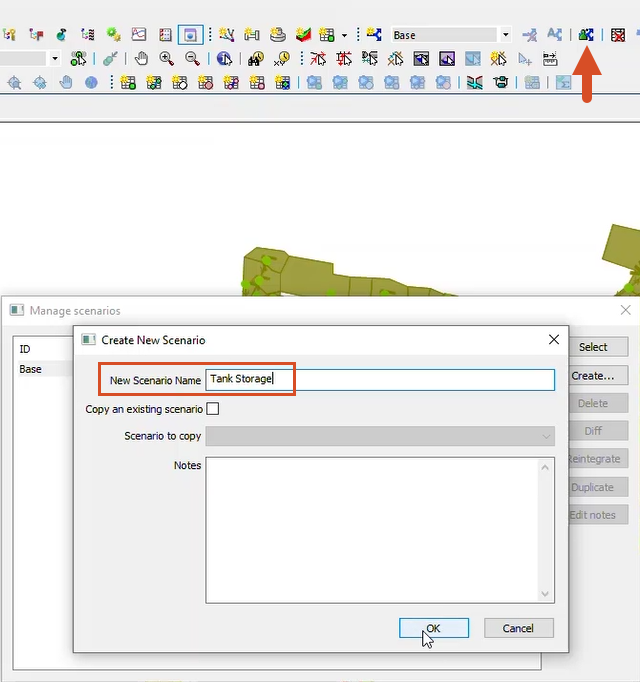
RTC can only be applied to certain link types, or more specifically, to links with variable properties.
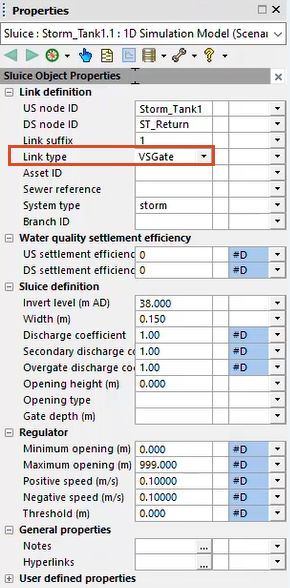
Once the change is made, regulator properties are added to the Properties dialog box.
The Select regulator popup appears, displaying all the regulator links in the model that can be controlled via RTC.
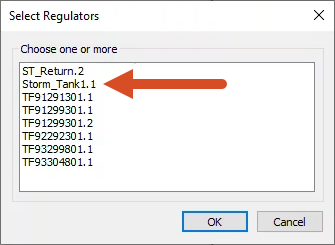
The regulator is added to the RTC tree structure, and the rules can now be defined for it to follow.
In this example, the sluice gate is to remain shut, unless the level within the inlet channel is less than 41.00m AD.
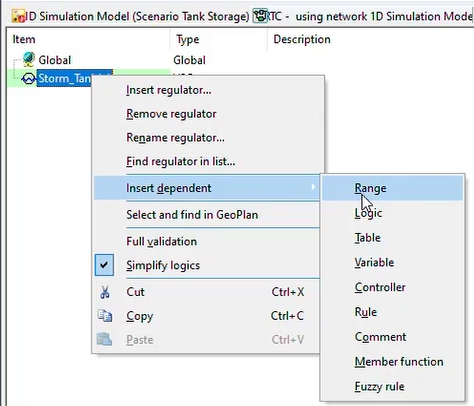
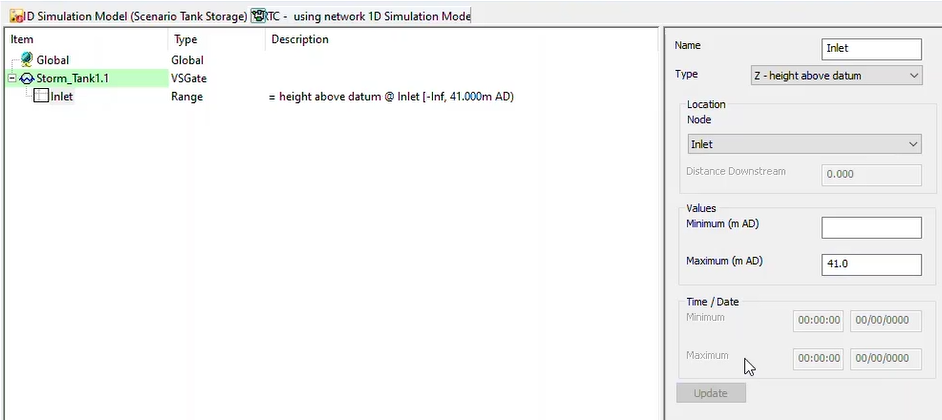
Now define the rules.
The variable for the VSGate is the opening height.
Next, define a second rule for when the sluice should open:
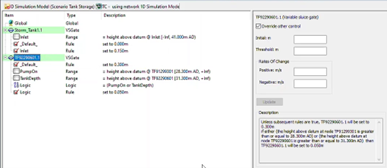
Now, define the rules for the upstream storage tank. The tank should contain flow when the downstream pumping station is on, and hold back the water until the online tank has drained.
To change link TF92290601.1 from a conduit to a regulator link, it needs to be deleted and then recreated.
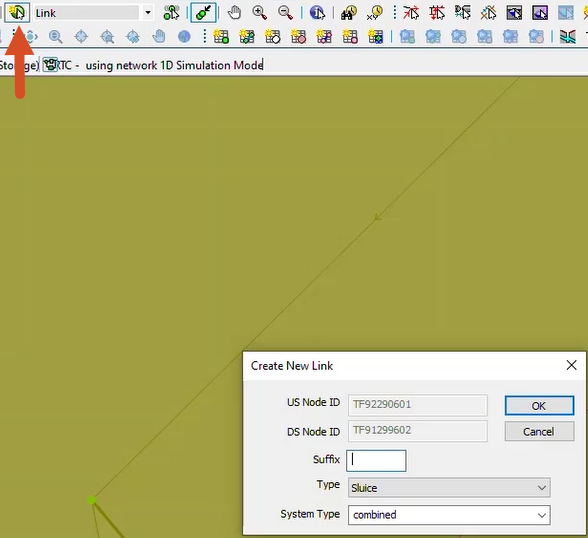
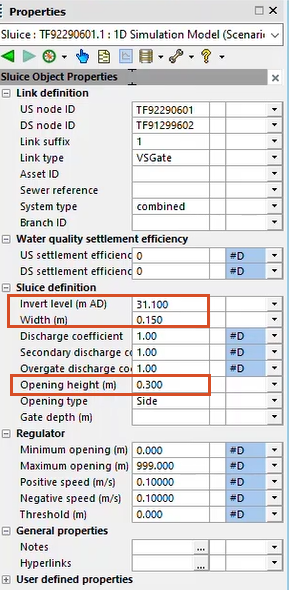
Set up the rules for this regulator:
The sluice should remain at a 50mm opening height during both of the range conditions. Use a logic table to set this up:
Finally, create a new rule that looks at the logic just created as its condition and sets the opening height of the sluice.
The RTC is now finalized.
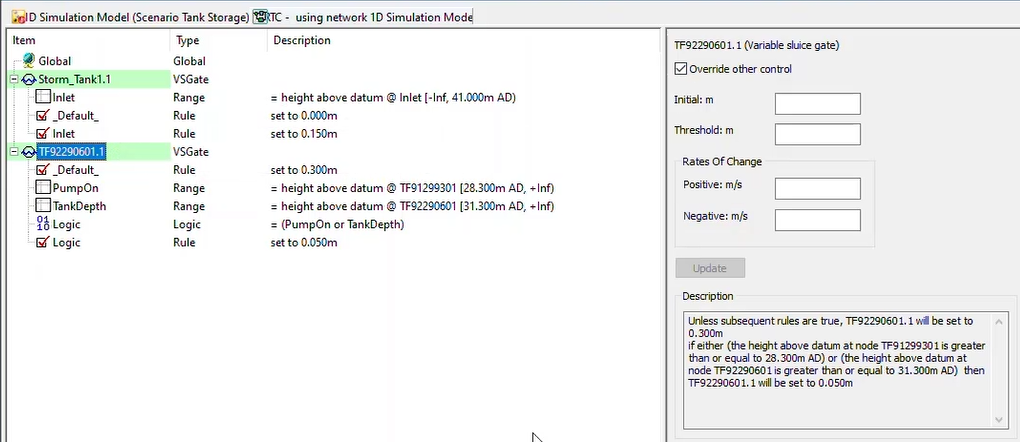
To use this RTC in a simulation, first, these latest changes need to be validated and committed.
The impact that the addition of the sluice and RTC have on the model and the spills from the storm tank are ready to be tested.
How to buy
Privacy | Do not sell or share my personal information | Cookie preferences | Report noncompliance | Terms of use | Legal | © 2025 Autodesk Inc. All rights reserved
Sign in to start learning
Sign in for unlimited free access to all learning content.Save your progress
Take assessments
Receive personalized recommendations
May we collect and use your data?
Learn more about the Third Party Services we use and our Privacy Statement.May we collect and use your data to tailor your experience?
Explore the benefits of a customized experience by managing your privacy settings for this site or visit our Privacy Statement to learn more about your options.